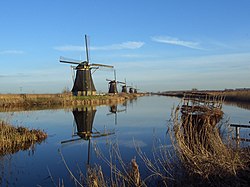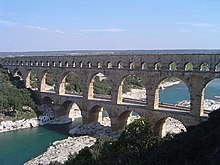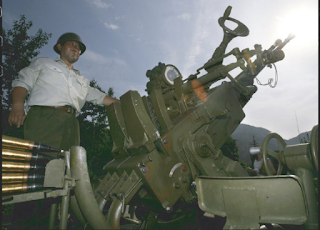A 2016 study found that countries whose agriculture depended on irrigation are more likely to be autocratic than other countries. The authors of the study "argue that the effect has historical origins: irrigation allowed landed elites in arid areas to monopolize water and arable land. This made elites more powerful and better able to oppose democratization.".(Reference: Bentzen, Jeanet Sinding; Kaarsen, Nicolai; Wingender, Asger Moll (2016-06-01). "Irrigation and Autocracy". Journal of the European Economic Association).
Indeed, but what about no arable land at all?
The best example history has given us in recent times is the story of Israel, in middle east.
Placed mainly in arid or desertic zones, the jewish tribe has succeded in few years where its previous inhabitants have failed for centuries. It is home to now three types of so called water harvesting technologies, and the inventor of the best water conservative irrigation method was Israelian as well.
In facts, he sold the rights of his technology to an hebrew agency, the drip irrigation by Simcha Blass has become the main business of Netafim. (Reference: Haaretz Article by Ruth Schuster)
Water Harvesing is the practise to find some drinkable water from unconventional solutions to drought. In Israel, alongside with an extensive use of desalination plants, it is common practice to "bomb" the clouds with silver iodine, thanks to guns, once devoted to Anti-Aerial combat. As a result, rain is artificially stimulated so to produce an extra amount of rainy water of about 20% more than without it. Also China, Russia and USA are now exploiting this technology.
Another technology which serves for water harvesting is about the smart recycle of the waste water.
De Artificialia Irrigationibus
giovedì 18 gennaio 2018
Risks related To Artificial Irrigation
The operating of an irrigation system comes along with side effects. Some of them is good, the most cases are not.
Themain consequences are on the environmental plan.
Here is a summary for the most significative.
Reduced River Flow.
In case of a river being the source for the water supply. It implies losses in the ecosystem and could produce salt water intrusion in delta or estuaries, in dry periods, not guaranteeing availability of drinking water to human populations as well.
Exhausting the aquifers may eventually lead to phenomena of land subsidence, with heavy damages to civilians.
Higher Water Table.
In the area interested by the irrigation it is common that a great amount of water for the irrigation goes through the terrain until it recharges the water table level, in the underground reservoir.
This being the opposite of water scarcity will imply problems about waterlogging and necessary drainage.
But neither the drainage process is in lack of issues. By draining away the water on tthe fertilized crop, a part of fertilizing chemical substances is released on the drinking water of the groundwater or into the nearest river, polluting it.
To avoid natural cathastrophes it is mandate by law to keep an eye on the level of salinity of the soil and on the underground reservoirs with frequent controls.
Themain consequences are on the environmental plan.
Here is a summary for the most significative.
Reduced River Flow.
In case of a river being the source for the water supply. It implies losses in the ecosystem and could produce salt water intrusion in delta or estuaries, in dry periods, not guaranteeing availability of drinking water to human populations as well.
Exhausting the aquifers may eventually lead to phenomena of land subsidence, with heavy damages to civilians.
Higher Water Table.
In the area interested by the irrigation it is common that a great amount of water for the irrigation goes through the terrain until it recharges the water table level, in the underground reservoir.
This being the opposite of water scarcity will imply problems about waterlogging and necessary drainage.
 |
| waterlogging in Netherlands |
But neither the drainage process is in lack of issues. By draining away the water on tthe fertilized crop, a part of fertilizing chemical substances is released on the drinking water of the groundwater or into the nearest river, polluting it.
To avoid natural cathastrophes it is mandate by law to keep an eye on the level of salinity of the soil and on the underground reservoirs with frequent controls.
 |
| Soil salinated land in Colorado, USA |
Specifications of the components
The following is an extract taken from Irrigation Specification, for Residential and commercial use.
SECTION 02811
IRRIGATION SYSTEM
From the company Century Equipment.
It describes precisely each part of the component, commercialised by such company, giving a tolerance and describing physically the shape.
"
[...]
C. Sprinkler Heads – Long Range
1. The full or part-circle sprinklers shall be a gear driven rotary type. The sprinkler shall be of a pop-up design with an overall height of 8-1/2”, a body diameter of 2-1/2”, a cap diameter of 3-3/8” and a pop-up stroke of 4”. The sprinkler shall be mounted at finish grade and shall have a 1” NPT or BSP female threaded inlet. The sprinkler shall be capable of covering up to a 52’ radius at 60 pounds per square inch pressure with a discharge rate of 10.2 gallons per minute. Water distribution shall be via two (2) nozzles that thread into a 2” diameter nozzle turret. The dual color-coded nozzles shall elevate 4” when in operation.
2. The body and cap of the sprinkler shall be injection molded from ABS, a non-corrosive, impact-resistant, UV-resistant, heavy-duty plastic material. The cover and nozzle top shall be injection molded from Alcryn, a synthetic rubber, and be capable of providing excellent impact resistance. The sprinkler shall be available with a plastic or stainless steel riser. The sprinkler shall have a plastic filter screen sized to prevent entry of foreign material into the nozzle. All components shall be removable from the top of the sprinkler case via a snap ring retention method.
3. The sprinkler shall have a single-piece riser/body seal that regulates flutings during pop-up and retraction to clear any debris from around the riser and a heavy-duty stainless-steel spring to ensure positive retraction. Rotation shall be accomplished by a water lubricated planetary gear-drive assembly driven by a variable reversing stator that maintains a constant speed of rotation with all nozzles. The variable reversing stator shall require no adjustments when changing nozzles.
4. The sprinkler shall incorporate an anti-vandal arc memory feature that allows the nozzle to be turned beyond its watering borders without incurring any internal damage. If turned beyond its watering borders, the sprinkler shall automatically return to the previously set arc. The sprinkler shall have a standard rubber cover available in black, or lavender for effluent water use applications.
[...]
"
SECTION 02811
IRRIGATION SYSTEM
From the company Century Equipment.
It describes precisely each part of the component, commercialised by such company, giving a tolerance and describing physically the shape.
"
[...]
C. Sprinkler Heads – Long Range
1. The full or part-circle sprinklers shall be a gear driven rotary type. The sprinkler shall be of a pop-up design with an overall height of 8-1/2”, a body diameter of 2-1/2”, a cap diameter of 3-3/8” and a pop-up stroke of 4”. The sprinkler shall be mounted at finish grade and shall have a 1” NPT or BSP female threaded inlet. The sprinkler shall be capable of covering up to a 52’ radius at 60 pounds per square inch pressure with a discharge rate of 10.2 gallons per minute. Water distribution shall be via two (2) nozzles that thread into a 2” diameter nozzle turret. The dual color-coded nozzles shall elevate 4” when in operation.
2. The body and cap of the sprinkler shall be injection molded from ABS, a non-corrosive, impact-resistant, UV-resistant, heavy-duty plastic material. The cover and nozzle top shall be injection molded from Alcryn, a synthetic rubber, and be capable of providing excellent impact resistance. The sprinkler shall be available with a plastic or stainless steel riser. The sprinkler shall have a plastic filter screen sized to prevent entry of foreign material into the nozzle. All components shall be removable from the top of the sprinkler case via a snap ring retention method.
3. The sprinkler shall have a single-piece riser/body seal that regulates flutings during pop-up and retraction to clear any debris from around the riser and a heavy-duty stainless-steel spring to ensure positive retraction. Rotation shall be accomplished by a water lubricated planetary gear-drive assembly driven by a variable reversing stator that maintains a constant speed of rotation with all nozzles. The variable reversing stator shall require no adjustments when changing nozzles.
4. The sprinkler shall incorporate an anti-vandal arc memory feature that allows the nozzle to be turned beyond its watering borders without incurring any internal damage. If turned beyond its watering borders, the sprinkler shall automatically return to the previously set arc. The sprinkler shall have a standard rubber cover available in black, or lavender for effluent water use applications.
[...]
"
Artificial Irrigation: A WorldWideMap
Here is the situation of national comunities about irrigating their crops.
source: Siebert, S., Döll, P., Hoogeveen, J., Faures, J.-M., Frenken, K., Feick, S., (2005): Development and validation of the global map of irrigation areas. Hydrology and Earth System Sciences, 9, 535-547.

source: Siebert, S., Döll, P., Hoogeveen, J., Faures, J.-M., Frenken, K., Feick, S., (2005): Development and validation of the global map of irrigation areas. Hydrology and Earth System Sciences, 9, 535-547.

Artificial Irrigation: Statistics.
From a Wikipedia page regarding Statistics about Irrigation, these are some interesting data:
- 94% of the application methods of irrigation water at field level is of the category surface irrigation, whereby the water is spread over the field by gravity.
- Of the remaining 6%, the majority is irrigated by methods requiring energy, expensive hydraulic pressure techniques and pipe systems like sprinkler irrigation and drip irrigation, for the major part in the USA.
The source of irrigation water in these cases often is groundwater from aquifers. However, the exploitation of aquifers can also be combined with surface irrigation at field level.
- Irrigation schemes in the world use about 3 500 km3 water per year, of which 74% is evaporated by the crops. This is some 80% of all water used by mankind (4 400 km3 per year).
- The water used for irrigation is roughly 25% of the annually available water resources (14 000 km3) and 9% of all annual river discharges in the hydrological cycle.
- Of the total irrigated area worldwide 38% is equipped for irrigation with groundwater, especially in India (39 million ha), China (19 million ha) and the United States of America (17 million ha). Total consumptive groundwater use for irrigation is estimated as 545 km3/year.
- Groundwater use in irrigation leads in places to exploitation of groundwater at rates above groundwater recharge and depletion of groundwater reservoirs.
References:
International Commission on Irrigation and Drainage (ICID). Link.
Bruce Sundquist, 2007. Chapter 1- Irrigation overview. In: The earth's carrying capacity, Some related reviews and analysis. Link.
S. Siebert, J. Burke, J. M. Faures, K. Frenken, J. Hoogeveen, P. Döll, and F. T. Portmann (2010). Groundwater use for irrigation – a global inventory. In: Hydrology and Earth System Sciences. Link.
Etichette:
China,
Groundwater,
India,
Quantities,
Statistics,
USA
Irrigation is a Theme: Literature.
The Roman Empire developed its fortune starting by a people of farmers and merchants.
During the second Triumvirus, in the second half of the I Century BC, two big alliances face in a struggle for the power.
In an attempt to acquire the most credit along the Senatus against Mark Antony, Octavian, the heir of Caesar, builds up a movement of poets and artists, to recall the old Repubblican virtues and to fight his opponent ideals, based on the oriental culture.
One figure of that movement is Virgil, the author of the Aeneid. But also another artist was present: Vitruvius, author of De Architectura.
It is the oldest treatise ever found about the subject of Architecture, and it contains many reference to the extensive water management expertise of Roman Engineers.
 |
| Pont du Gard |
Inside books VIII and X he described aqueducts as well as dewatering machines and other instruments of that age which were involved in the process of distribution and transportation of the water.
 |
| A part of an old Roman Water Wheel, found in Spain, that testifies the technological level reached by the ancient civilization. It is on display at the British Museum. |
Numbers around Artificial Irrigation
Taking into account a house related irrigation facility for the sake of simplicity, there are few key quantities to keep in mind.
Related to the pipelines
A.)Nominal Water Flow. (litres per minute)
E.g. 45 l/min.
B.)Working Pressure. (kiloPascal or Bar)
Related to the sprinklers
E.)Range. (metres)
E.g. 5 m.
F)Area of coverage. (square metres)
E.g. 8mx8m.
source: Hunter Industries, Guida alla progettazione. Impianto di irrigazione per spazi verdi residenziali.
Related to the pipelines
A.)Nominal Water Flow. (litres per minute)
E.g. 45 l/min.
B.)Working Pressure. (kiloPascal or Bar)
E.g. 3,5 Bar.
C.)Maximal Water Flow. (litres per minute)
E.g. 60 l/min.
D.)Diametral Section. (millimetres)
E.g. 25 mm.
E.)Range. (metres)
E.g. 5 m.
F)Area of coverage. (square metres)
E.g. 8mx8m.
source: Hunter Industries, Guida alla progettazione. Impianto di irrigazione per spazi verdi residenziali.
Irrigation is a Theme: Movie.
In the race of finding the right chemical compound to enhance field productivity, not every compromise is going to work:
Set in a dystopian world, Idiocracy is a 2006 American satirical science fiction comedy film directed by Mike Judge.
It is the story of two "average Americans", who find themselves in an unlikely future where the standard IQ has lowered so much that they suddenly become considered as the most intelligent persons on the earth. For this reason, they are requested to solve a drought situation in the USA country.
That is when they realise that, instead of water, crops are being irrigated with energetic beverages.
Here is the scene just described.

Set in a dystopian world, Idiocracy is a 2006 American satirical science fiction comedy film directed by Mike Judge.
It is the story of two "average Americans", who find themselves in an unlikely future where the standard IQ has lowered so much that they suddenly become considered as the most intelligent persons on the earth. For this reason, they are requested to solve a drought situation in the USA country.
That is when they realise that, instead of water, crops are being irrigated with energetic beverages.
Here is the scene just described.

Irrigation is a Theme: Music.
A very important person from the 70s, the Canadian Neil Young, in 2016 released Peace Trail, his 37-th studio album.
At track number 7, John Oaks, he tells the story of a naive farmer, in a country ballad.
In the first verse, the author exploit a scene of farming irrigation as a model of the quiet life to depict the character of his song.
More about the song here.
Which is the best way to describe watering facilities?
Building plants to provide irrigation, is a matter of engineering.
The precise branch is hydraulic engineering, which belongs to the civil engineering area. As a matter of fact, it is possible to uniquely describe a facility or a system, with a document. A report is used to describe modifications, tests, or maintenance. For the system as a whole, a project relation would be the reference.
Here is an example from a project to improve the Crow Irrigation Project, located in North America, USA.
The precise branch is hydraulic engineering, which belongs to the civil engineering area. As a matter of fact, it is possible to uniquely describe a facility or a system, with a document. A report is used to describe modifications, tests, or maintenance. For the system as a whole, a project relation would be the reference.
Here is an example from a project to improve the Crow Irrigation Project, located in North America, USA.
Shapes and Functions of the Articial Irrigation
The main function of the irrigation process is to be related to the agriculture.
But there is more, other ways this technique can be employed for.
Agricultural Applications
Their main aims are to improve the yield of the fields, that are naturally watered by rainwater or occasional floods. More classifications can be made according to the specific aim of the irrigation or following the methods employed:
Surface instead of Subsurface irrigation:
The former being the most common way since primitive societies were born, is based on canals and banks; the latter depending strictly onto the soil configuration and often the technology available.
Drip irrigation or Sprinkler irrigation:
The first allow for more controlled watering, the last is simply the spraying of water over the fields by means of whatsoever technique involving gauges and sprinklers, with no guarantees about uniform watering.
Dust Control
There exist national regulations regarding the emission of dust in the atmosphere. For example, demolishing a building require to spray the building site with water, while dust is being generated. This way, dust is kept down.
" La valutazione dello stato della qualità dell’aria ambiente è regolata dalle direttive europee 2008/50/CE e 2004/107/CE e a livello italiano dal D.Lgs 155/2010 e s.m.i.."
source: ISPRA.
Mining
During the first stages of mineral mining, there's a process called "leach cycle", which involves irrigation of mineral chunks with a leach solution, to dissolve the valuable mineral and take it apart from the rest. Drip irrigation is preferred not to ruin the material.
Animal Husbandry
This is another field where irrigation techniques are applied. Feeding large amounts of animals requires hydraulic efforts. There can be both open containers both enforced tubes, according to the policy of the breeders.
Materials of Irrigation
Talking about irrigation involves also the simplest types of watering, such as the bucket and the garden hose.

Basic vinyl(PVC) hose (reinforced with a radial cord) is the least expensive and most lightweight option but also the least sturdy. It’s more prone to kinking, splitting and cracking than other materials and can degrade quickly if left in the sun or exposed to harsh weather.
Rubber hoses are generally the strongest and most long-lasting, but also carry the highest price tag and can be heavy to haul around the garden. Rubber has the added benefits of being able to carry hot water, being less likely to kink, and resisting cracking and ozone deterioration
A trade-off is a composite rubber/vinyl garden hose.
Reinforced hoses (reinforced with a mesh lining between layers of vinyl and/or rubber) are more resistant to kinking and splitting, and can take higher water pressure levels.
Structural Elements for Artificial Irrigation
Even though the main feature for irrigation systems has been around agricoltural purpouses, its techniques are also used for cooling livestock, dust suppression, disposal of sewage, and in mining.
For the scope of agricolture, it is possible to find some basical elements.
The irrigation system consists of an intake structure, usually a pumping station, a system to convey the water, another for the distribution, one for the field application and a system for draining.
So, for each system named up, these are the representative components:
The Pump:
Directs water from the source, such as reservoirs or rivers, into the irrigation system. It is nowaday mostly an hydraulic engine, consuming electric power.
Dikes and Conduits:
An open canal, channel, or ditch, is a waterway not constrained into a closed structure whose purpouse is to carry water from a spot to another.
Pipelines:
A pipeline network is required to reach the fields from the canals, up until the outputting valves into the field.
Sprinklers:
They are the endpoint valves dedicated to diffusion of the water in the open air to the land.
For the scope of agricolture, it is possible to find some basical elements.
The irrigation system consists of an intake structure, usually a pumping station, a system to convey the water, another for the distribution, one for the field application and a system for draining.
So, for each system named up, these are the representative components:
The Pump:
Directs water from the source, such as reservoirs or rivers, into the irrigation system. It is nowaday mostly an hydraulic engine, consuming electric power.
Dikes and Conduits:
An open canal, channel, or ditch, is a waterway not constrained into a closed structure whose purpouse is to carry water from a spot to another.
Pipelines:
A pipeline network is required to reach the fields from the canals, up until the outputting valves into the field.
Sprinklers:
They are the endpoint valves dedicated to diffusion of the water in the open air to the land.
A Journal Reference To Ancient Watering Technology
It has been possibly the first technology humans have ever developed.
As peoples started to settle and abandone nomadic habits, agriculture has evolved.
According to recent archaelogical finds, an ancient fortification in the Desert of Jordan, Israel, shows signs of advanced irrigation systemes. The complex has been approximatively dated back to 4000 BC.
Original article found on Haaretz(i.e. "The Land", in Hebrew), Israelian Newspaper on line.
https://www.haaretz.com/archaeology/mysterious-6-000-year-old-fortresses-found-in-jordan-1.5436040
As peoples started to settle and abandone nomadic habits, agriculture has evolved.
According to recent archaelogical finds, an ancient fortification in the Desert of Jordan, Israel, shows signs of advanced irrigation systemes. The complex has been approximatively dated back to 4000 BC.
Original article found on Haaretz(i.e. "The Land", in Hebrew), Israelian Newspaper on line.
https://www.haaretz.com/archaeology/mysterious-6-000-year-old-fortresses-found-in-jordan-1.5436040
Iscriviti a:
Post (Atom)










